Complete guide to get a motor scooter licence in Taiwan
Content
Introduction
If you are in Taiwan with an ARC or Gold Card or similar, you are eligible to get the “ordinary heavy-duty motorcycle” license. This allows you to drive motor scooters with up to 249cc, the so called “white plates”. Yellow license plates start at 250cc – those licenses are more difficult to obtain. The “cc” refers to engine displacement, measured in cubic centimeters.
The standard scooter in Taiwan has 125cc. This size provides a good balance between lower weight, swift acceleration, nimble navigation in cities and is still powerful enough (and has a big enough tank) to go into the mountains for a daytrip for 2 people.
Being able to drive a scooter really opens up the country in a different way, especially outside of the cities. And even in those cities, you can conveniently grab electronic scooters right off the street for sporadic commutes, i.e. at night when the MRT is not running anymore. The most popular services for scooter rental are WeMo and GoShare. They do not require paid subscription – they are simple “pay by the minute” systems, similar to YouBike.
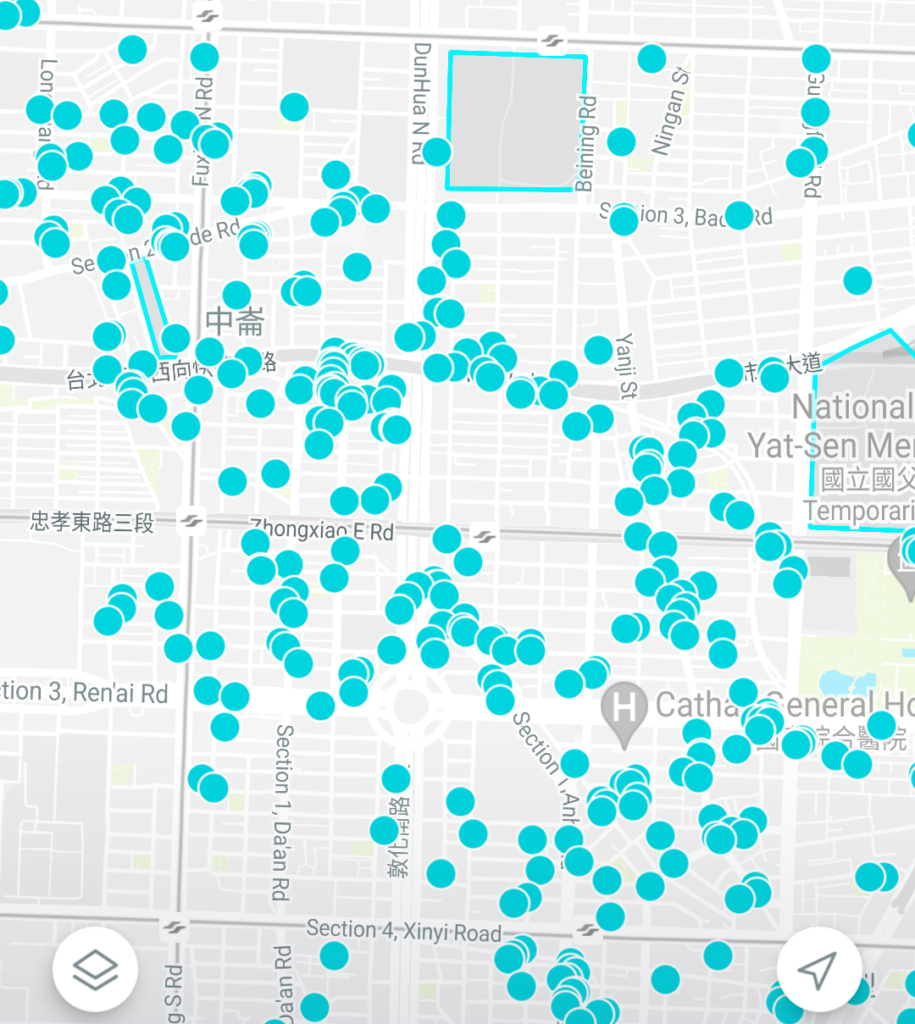
Screenshot: available GoShare scooters around Zhongxiao Fuxing MRT station on an average Sunday at 7pm.
Together with the paperwork, medical exam and license fees, the total investment amounts to around only NT$1000 or less. The whole official ordeal can be done in a single day.
Of course, you can only drive safely if you have studied the material well and have practiced the exam. The more you study and practice, the higher your score will be on the written and practical test. The more confident you become in following the rules and handling your vehicle, the safer it will be for everyone.
How this article differs from other blogposts
Other bloggers have already written posts about how to get the license. Such posts include:
- About Getting A Scooter License in Taiwan
- How to Obtain a Scooter License in Taiwan?
- 11 Steps to Pass the Scooter License Taiwan [2024 Guide]
- Scooter Saga Part III
This article attempts to avoid personal narration and instead focus more on links to official resources and to provide helpful illustations. The end of the article consists of my own notes which I took during the time I studied the written exam’s material, highlighting some of the less obvious knowledge about road rules and safe driving in Taiwan.
A few words on exchanging an international driver’s license
If you already have a driver’s license in your own country, there might be procedures with which you can exchange your home license against a Taiwan international license, as outlined on this government website:
However, considering the low cost of passing the local driver’s license test, if you have an ARC (or better), I would still recommend to go for the “proper” local license. There is simply much to learn by reading through the course material and practicing and mastering the road test training ground. The additional challenge is paid off by being a better informed and hopefully more considerate driver in the future.
Download the official course material (PDFs)
Driving school consists of you studying the material at home. The PDF files are unceremoniously provided on this website:
Available languages are Chinese, English, Indonesian, Japanese, Thai, Vietnamese, and others. The site does not allow to filter by language.
Here is a table with links to the English and Chinese versions. Download all of them in your preferred language.
There is quite a bit of redundancy and overlap between these files, but that won’t hurt your learning effort too much. The Chinese language has one more file than the English language, but due to all the redundancy I don’t think you will miss out on anything. The last two files in each list have “New” and not “New” versions, but both have the same upload date, so I included all. The files are listed in the same order as presented on the official website.
Link to official practice app
As an alternative to the PDF files, the rules can also be learned and practiced in an official app:
I haven’t used these apps, but I heard they are multilingual. I would recommend going over the PDF material first, as you can print or read them on a bigger screen without any distractions.
Link to official “dry run” of the written exam
The following link will allow you to test yourself on the written exam. The system on that website is 100% identical to the system you will encounter during the actual exam.
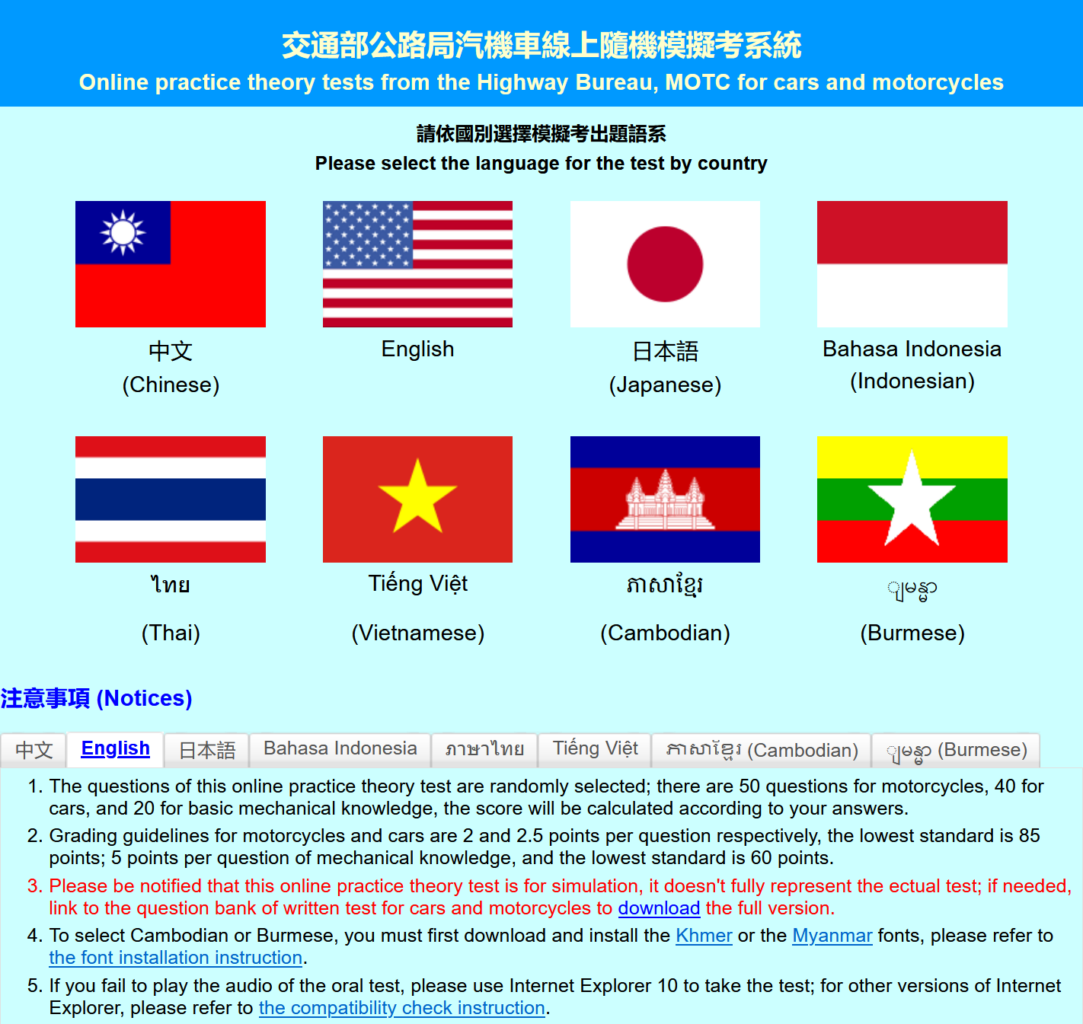
Here is one random example question:
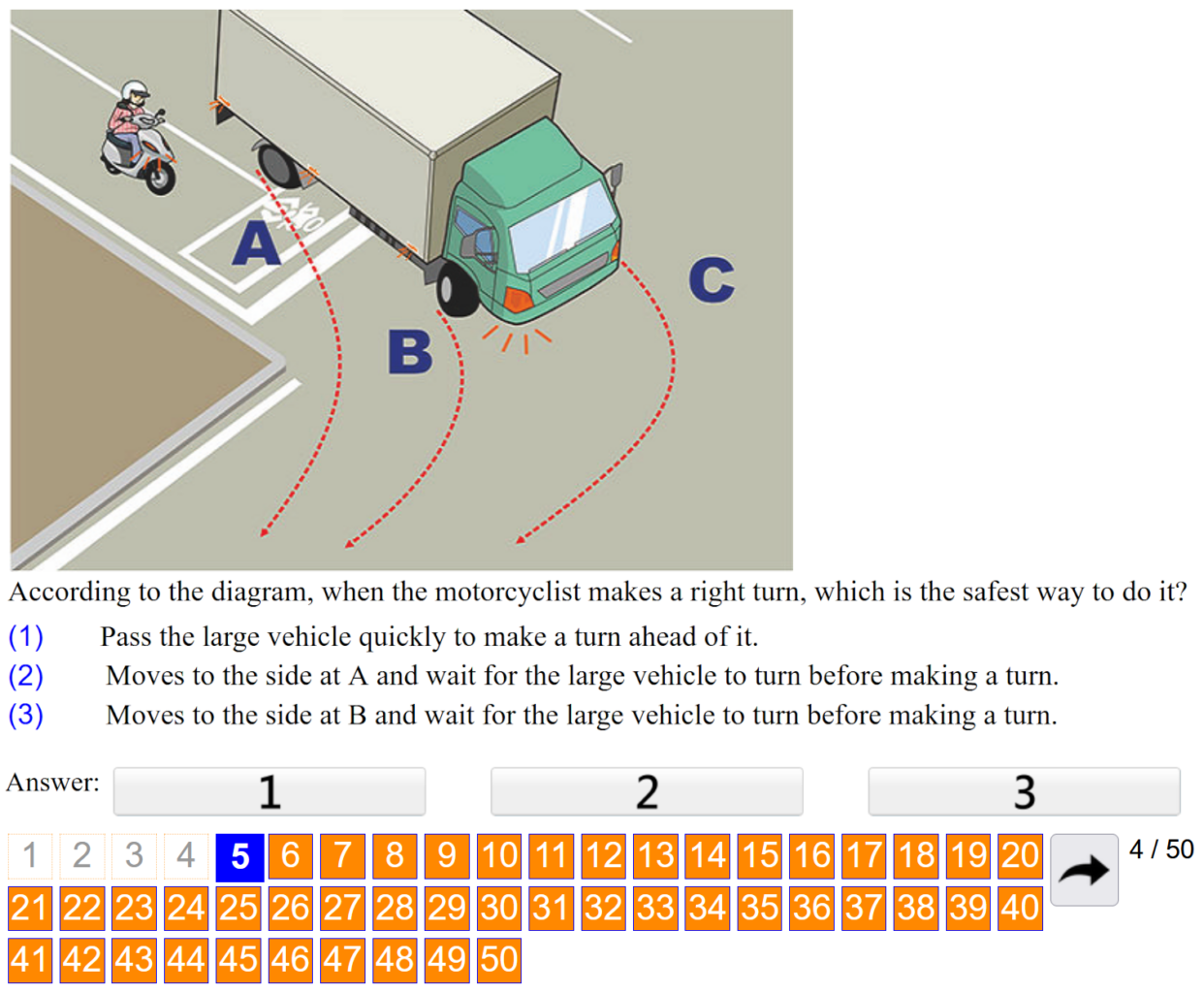
For each run, the system randomly picks 50 questions from the pool. Every time you “play” you will get a set of different questions. Follow this link to practice the exam:
You must be able to pass this exam before you can continue to the practical exam.
Official videos with instructions for the practical exam
The MOTC provides official videos that explain every single step of the practical exam. There are multiple such videos from official sources, each from a different city.
| From Taichung | https://youtu.be/KVzocq5YuiQ |
| From Kaohsiung | https://youtu.be/-lZ3H3o5VGU |
| From Chiayi | https://youtu.be/OHtx8sJntaI |
It is highly recommended to watch at least one of these videos. All cities follow the same test criteria, so it doesn’t matter which one you watch.
I found the video from Taichung to be the best in terms of clarity and presentation. It’s also the longest video of these three.
Practicing scooter handling on training ground areas
The practical exam consists of a small’ish circuit that tests you in various standard driving situations. Among those are:
- Ride a very narrow line as slowly as possible
- Take very tight turns without losing your balance
- Stop and go at the appropriate moments
- Signal for turns and lane changes
- Look left and right at the appropriate moments
This test circuit is standardized and identical at all testing locations. Here is how it looks like:
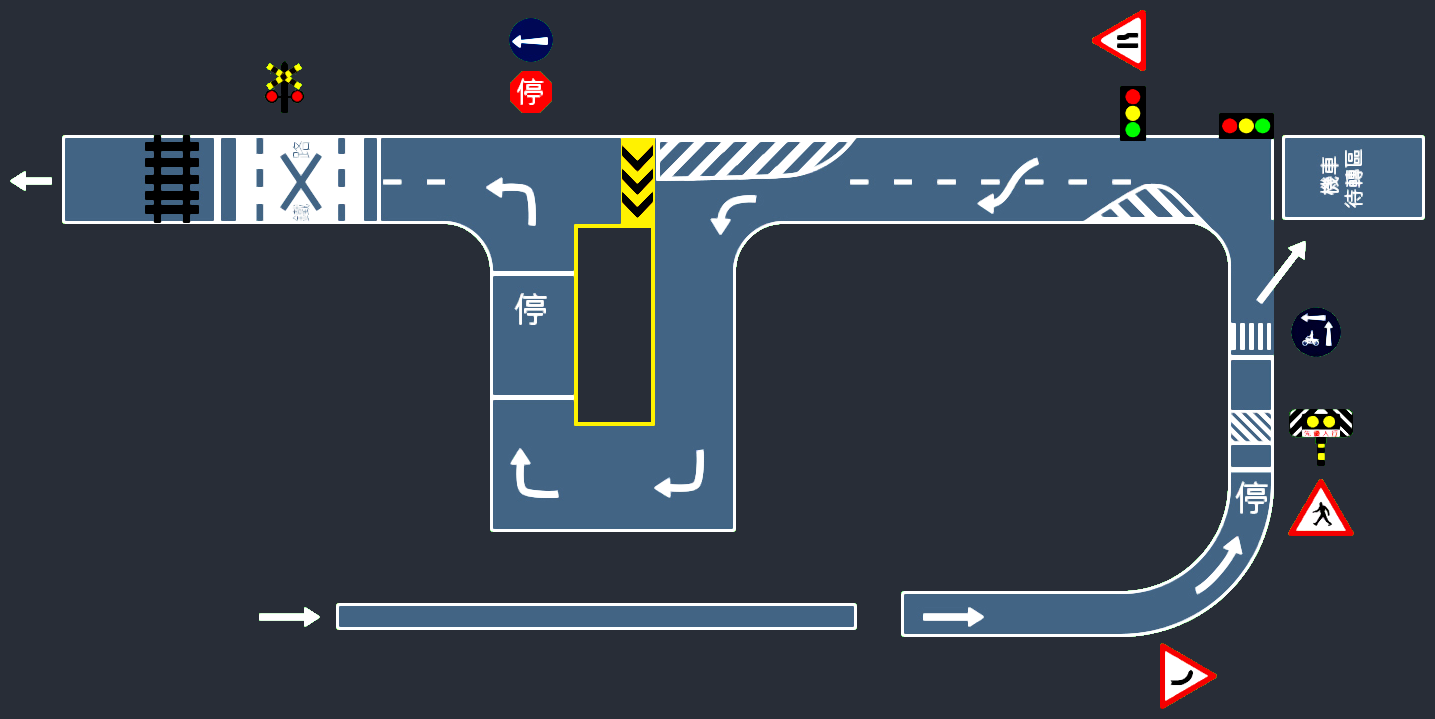
The picture is derived from this official source:
The same circuit is available to practice for free at quite a lot of locations throughout Taipei, most of them around the riverside parks. Most if not all of them can be used all day, all night. There is no staff and there are no other facilities – just you, your (friend’s) scooter and a varying number of other people who are practicing.
I found 10 such locations in and around Taipei. Here is a list of pins on Google Maps with those locations:
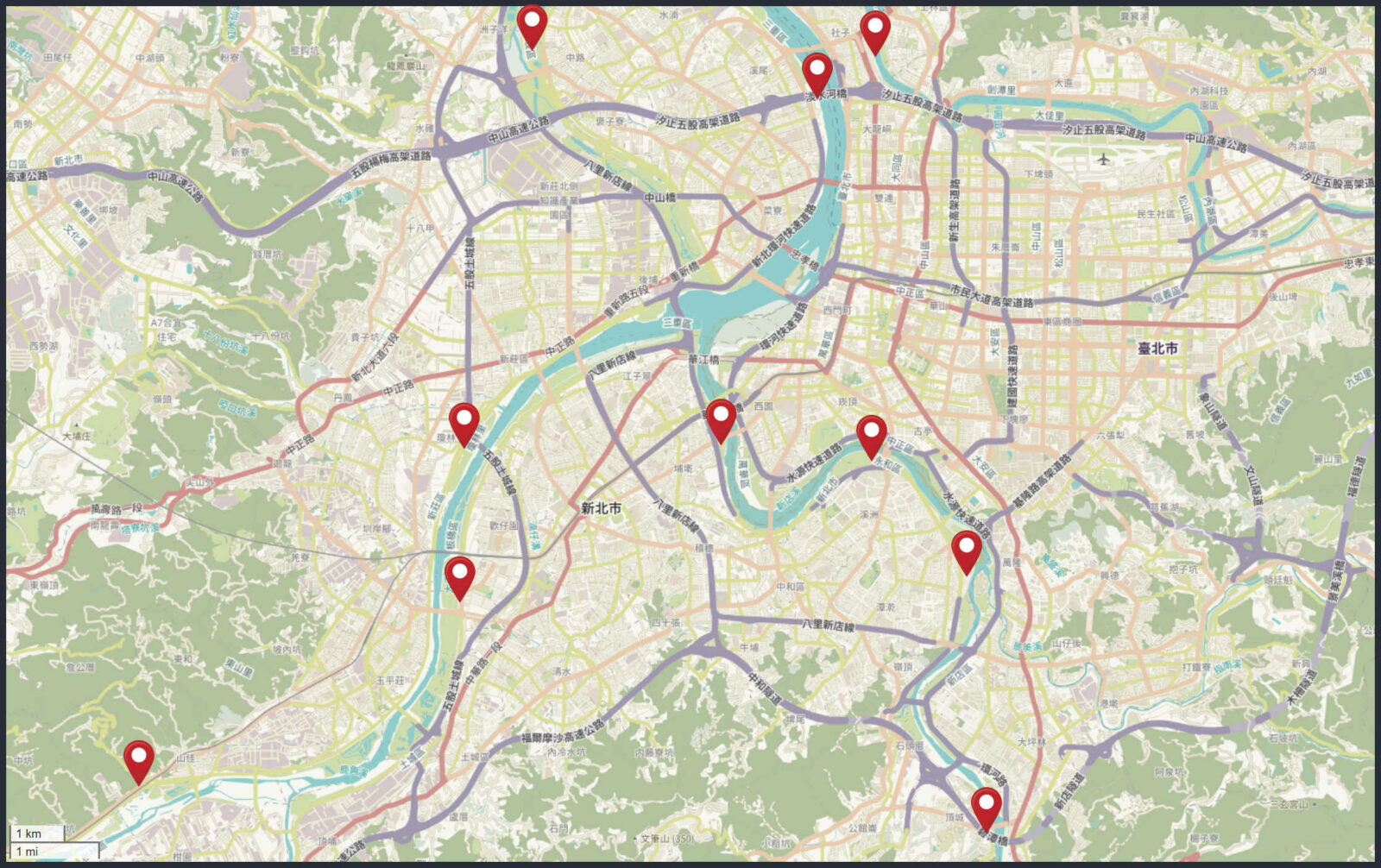
Permalink: https://maps.app.goo.gl/TQwNxUTN2k72XLPs5
I would recommend to practice at one of them as much as possible, especially if you are a beginner in motorized two-wheel driving.
Please note:
- The “narrow line” in the actual test is more narrow than in the training ground areas, because the bumpy sensors that detect whether you have crossed the line are going to be on the inside those painted white lines.
- The actual exam circuit will have traffic lights at intersections.
See the videos linked above for details. Again: watching at least one of these videos is highly recommended before you start practicing on one of the training grounds.
Signing up for the mandatory safety training
Before you can take the exams, you need to sit in an official 2 hour mandatory safety training classroom. The slots for these classes are limited, so you must sign up for them in advance.
By signing up for this class, you basically set your own deadline on which you must be able to pass the exams. Because the safety training, medical check and exams are all around the same location, you can do everything in one single day.
The sign up is done on this website:
If you are not fluent in reading Chinese, you will need to use translation services. Some tips:
- Google Chrome offers a built-in website translation tool. Firefox has plans to follow suite.
- If translation in the browser does not work, use the camera function in the Google Translate or Google Lens app on your phone. If you have an iPhone, download Google Translate from the App Store. With the camera function, you can point the phone at any text on your screen (or signboards, restaurant menus etc.) and translate directly from Chinese to English.
The government agency provides this PDF file in English to walk you through the registration process. Here are the most essential steps:

Locations in and around Taipei are:
Before you can confirm your location and timeslot, the website will ask you to do a very basic video test where you press a button during moments of danger.
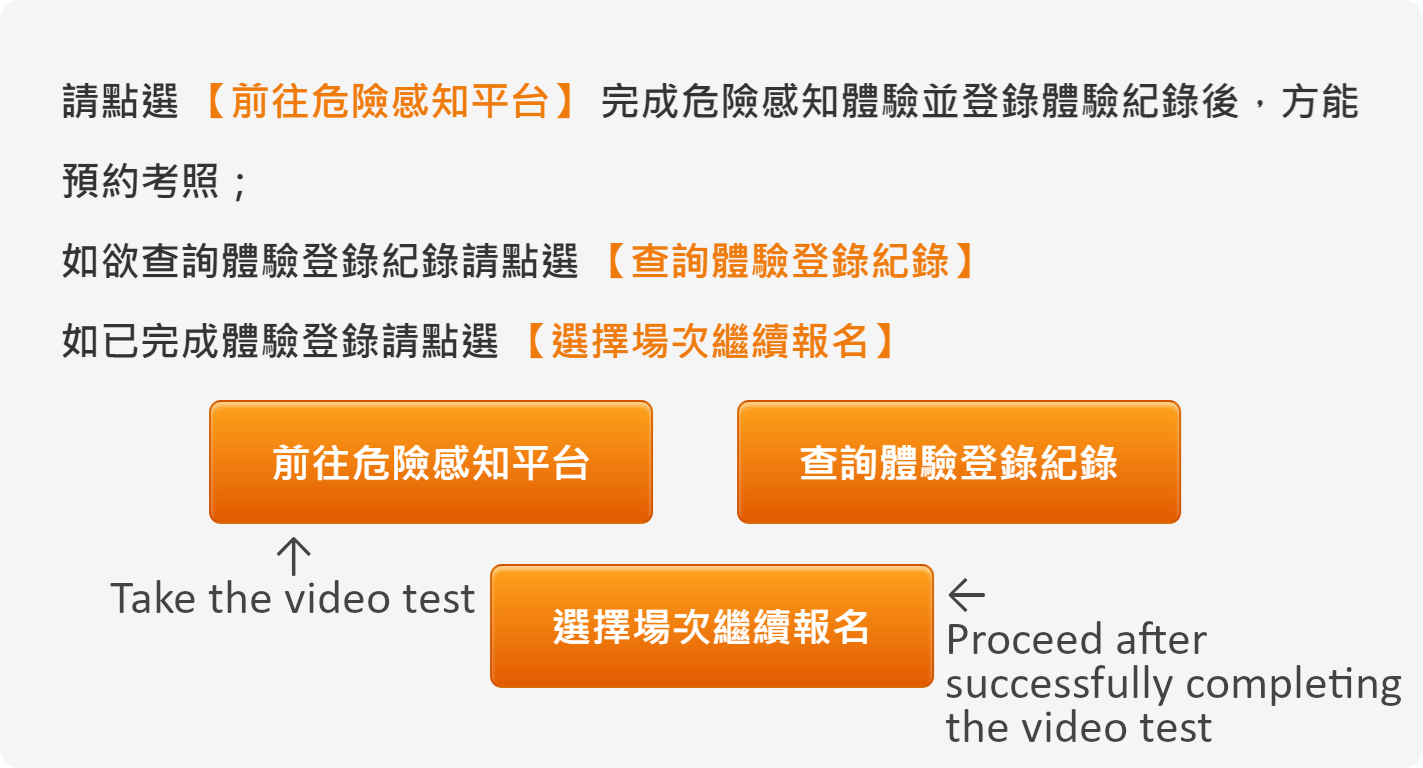
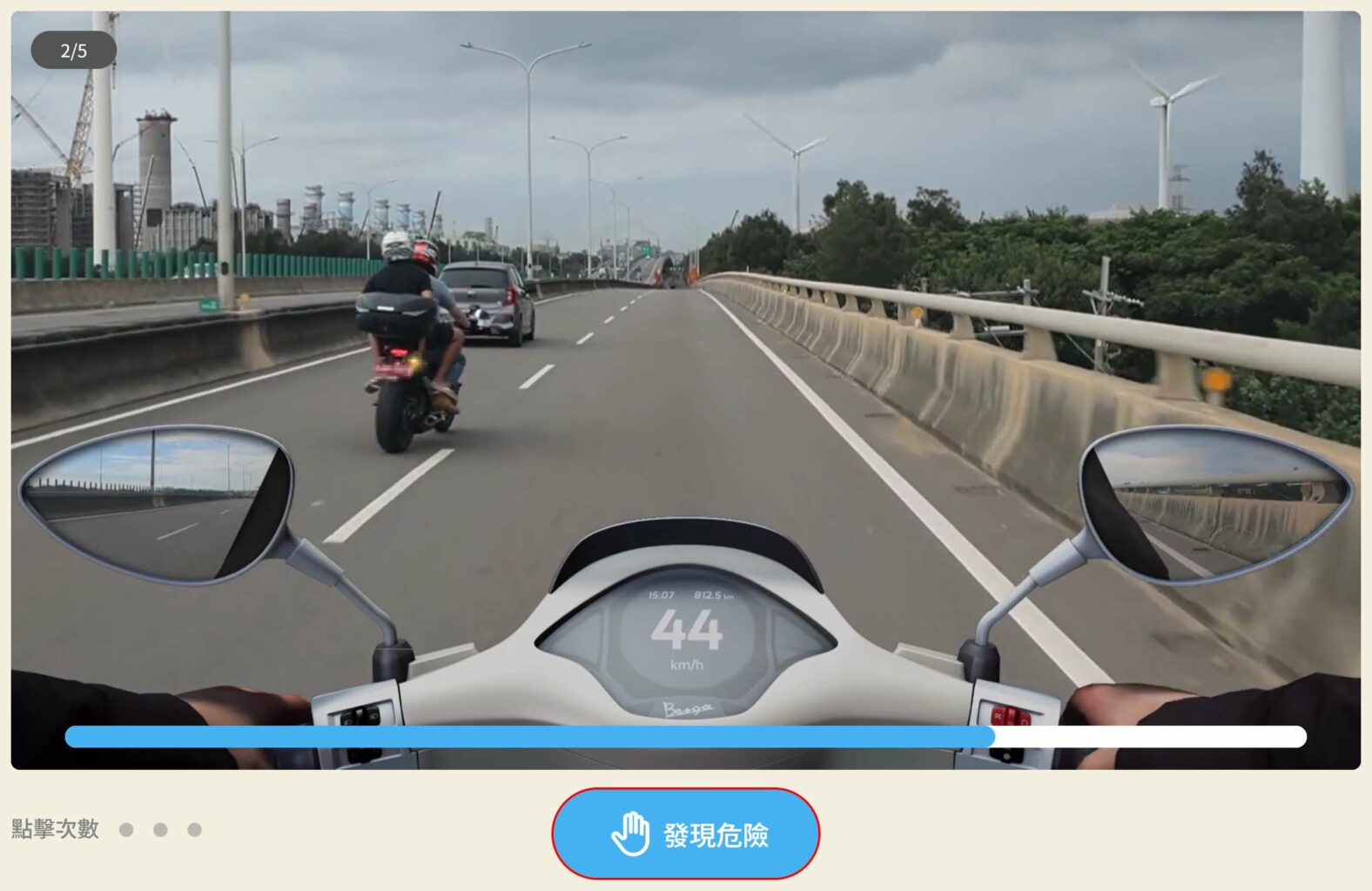
The test consists of five stages, each playing a video of a presumably staged traffic situation. Press the blue button during moments of danger. After the fifth stage, the system will inform you whether or not you have missed any moments. For each stage that you failed, the system will prompt you to watch a secondary video, which will show the same traffic situation again and explain when and why there was a moment of danger. You must watch all those videos before you are allowed to retake the test. Repeat until you pass.
Once you pass this test, the system will ask for your ID number and birth date. It will save your credentials together with the fact that you have passed this video test.
When you return to the initial date-picker dialogue, click the “proceed” button and enter your credentials. The system is now aware that you passed the video test, so you are now eligible to pick a date for the mandatory safety class and will allow you to proceed.
When picking a date, watch out: there are two types of safety classes:
- Those for people who have gotten their license suspended and who need to re-take the class. Those classes usually have a lot of free slots. They are marked with “not for beginners” in Chinese.
- The other ones – for those, who take the class for the first time. They usually have a much lower number of remaining slots and they might be fully booked for at least 2 weeks in advance. By using a translation service during the booking procedure, you will easily be able to find the right time slot for you. If you can’t find an open slot, pick another date further out in the future.
I would generally recommend to book a class in the morning or before lunch time, as this would still give you plenty of time to pass all the exams in the afternoon on the same day.
The big day
You have studied the material, sufficiently practiced the test circuit and passed the written mockup test without fail. The day has come on which you may get your license. Roughly speaking, the day looks like this:
Prepare your material
You will need to bring the following material:
- Your ARC or similar identity document.
- Three identical, glossy ID card pictures in the 1-inch format (about 2.5 cm × 3 cm in size).
- A valid scooter helmet. Valid helmets are those with a “DOT” or “SNELL” mark.
If you don’t have passport pictures yet, there are should be a photo booth vending machine at each DMV location. They usually allow you to pick your prints between “big”, “small” and “combo” sizes. The 1-inch format is the “small” size, so better pick that one.
A few words on the medical exam
I cannot say for certain that all of the DMV locations listed above have their own medical examination office. I know that the Shilin location definitely has. The medical exam office may not be located inside the DMV building but in the immediate neighborhood like across the street. Local staff will be able to direct you. The exam consists of very basic fitness, eyesight and hearing tests.
You could also take the medical test at any of these public clinics ahead of time:
- Highway Bureau, MOTC: Physical examination hospitals (in Chinese)
The certification is valid for 12 months.
Go through the stages
- Go to your location ahead of the assigned time.
- Find the facility for the medical check.
- Get your signed paper that you have passed the medical check.
- Sit in on your 2 hour safety class.
- Find the queue to sign up for the written test on site.
- Pass the written test.
- With your (friend’s) scooter, find the queue to proceed with the practical test.
- Relax. Remember your training.
- You have two attempts at passing the “narrow line” part of the test.
If you are unsure how to navigate this day, rest assured: everything is layouted in a fairly obvious (with bi-lingual signposts) and there will be plenty of people who speak English or who will find someone who speaks English to help you out if you have any doubts. This includes the doormen and security guards – basically anyone who is wearing a uniform. Just ask. During each stage, you will get a signature on a paper slip that will certify that you have passed that stage. Don’t lose this paper slip!
If you have successfully passed the final exam, find the counter where you pickup your official driver’s license on the same day. It takes the counter only a few minutes to hand out the paper.
If you failed the test, come back again in 7 days or more for another attempt at that test. Practice more. You do not need to sign up for the exam again. The sign up was only for the 2 hour classroom session.
My own notes of non-obvious rules and trivia (unofficial learning)
Preface
Now that we have gone through all the steps of how to get your license, I will wrap up the article with my own loose collection of non-obvious rules and facts about driving scooter in Taiwan. All items in this document are taken (or interpreted) from the official English course material, recorded around October 2022.
Disclaimer
These paragraphs do not aim to be a complete or comprehensive lecture. Instead, it may only serve as a quick primer to get you up to speed. Remembering only the items in this mere document will not be sufficient to pass the written test because the written test requires the knowledge of additional numbers, some of which may be trivial and arbitrary.
Scooter Setup and Technicalities
- Baggage
- Baggage no greater than shoulder height; no 10cm wider than handlebar
- No more than 0.5 meter behind rear wheel axle
- White plate can carry up to 80kg baggage, Green plate up to 50kg baggage
- Scooter must have basic repair tools in trunk
- Brakes on scooter
- right lever = front brake
- left lever = rear brake
- Bicycles have it the other way around.
- Tires
- Tire threads need to be at least 1mm deep, otherwise change tire.
- When the tire tread wear is horizontally aligned with the indicator, replace tire.
- Typical tire spec “3.50-10-8PR” = 3.5 inch tire width and 10 inch inner diameter of tire.
- Simple pressure test: if the front tire temp is not higher than the environmental temperature, pressure might be wrong. (Not sure if I got this right.)
- Tires can be used for up to 6 years after manufacturing (storage life, not usage life).
- Manufacturing Date Code Example: MMD1213 = 12th week of 2013
- Having soft suspension does not decrease tire wear.
- Side mirrors are convex (not concave).
- Helmets should be tight, but not too tight.
- Not using scooter? Let engine run for 3~5 minutes once a week to maintain good conditions.
- When replacing battery (lead-acid):
- Remove negative (minus) cable first!
- After replacing: add positive (plus) cable first!
- If you do this wrong, you might get sparks flying. This was dangerous in the past when older batteries were prone to leaking gas.
- This applies to the lead-acid battery that is in every combustion-engine car or scooter. This does not apply to Lithium batteries in modern electrical vehicles.
Road rules
- Speed limits for scooters
- No traffic signs: 50 km/h
- No traffic signs but interrupted yellow line (i.e. ability to cross into counter-traffic lane to overtake slower vehicles): 40 km/h
- No traffic signs but markings separating fast and slow lane: 40 km/h
- One-way road without markings: scooters should keep on far right or far left side of the road, not drive through the middle
- Turn signal must be activated already 30 meters before reaching the intersection.
- I don’t like this rule because it often causes scooters to signal too early, passing alleys and pedestrians being afraid to cross the alley because the pre-mature signaling causes pedestrian to assume that the scooter or car will turn right into the alley when in fact it will go past and only turn at the bigger intersection. Signalling should be more context-aware, i.e. signal to indicate a turn at the next possible section, after passing the last alley before the intersection.
- Nomenclature translation English to German:
- Nebenstraße = „Branch Road“
- Hauptstraße = „Main Road“
- “Right of way” rules:
- When two roads meet, the road with lower number of lanes is considered the branch road and must yield to other road (main road), unless otherwise specified by traffic signs.
- At intersection between vehicles that come from the same road: turning vehicle should let neighbouring, straight-going vehicle go first. Arriving first at the intersection (informal “head first” tradition) does not matter. Typical situation: scooter in right lane go straight first; right turning car has to wait for scooter to pass on the right.
- At intersection between vehicles that oppose each other: if left turner and opposite right turner want to turn into the same lame, the left turner has right of way. In other words: “right before left” does not apply in this situation. This is because the left turner at an intersection has to cross more distance of the intersection and is thus in a more sensitive spot and should get out of the way first. Imagine the right turner does not yield, the left turner would have to stop half-way in the middle of the intersection, potentially blocking traffic. Thus, left turner goes before opposite right turner.
- When meeting on a hill/slope, car going uphill has right of way. Because climbing is more difficult than going down. You don’t want to stop midway during a climb to yield to another car.
Parking
- Temporary parking must have 10 meters distance to intersections, bus stops
- In No Parking zone you can still park from 8pm to 7am (at night). And temporary during the day (up to 3 minutes).
- Temporary Stopping Zone. What is it? Neither temp nor regular parking allowed.
Behaviour on the road
- Never honk longer than half a second and never more than 3 consecutive times
- Hear siren from ambulance, police, fire track etc? Yield immediately.
- If you want to pass a slower car in the same lane, honking twice (half a second twice) is OK; alternatively, flash your lights once (i.e. high-beam light, aka “fog lights”). This may help to notify the other vehicle that you will pass.
- If someone comes your way with high-beam lights and does not switch down, ignore it and move on. Don’t honk or flash lights for warning. In other words: concentrate on your own driving instead of playing civil police.
- Accidentally ended up with your scooter on freeway by taking the wrong turn? Carefully and slowly ride back on the shoulder side (i.e. right shoulder, outside the right-most lane as seen from direction of traffic) against your lane’s traffic toward the original interchange to exit the freeway. In other words: do not attempt a U-turn into the “correct” traffic lane first. Just turn around on the spot. (Course material did not comment on possibility of pushing and walking instead of riding.)
Safer driving
- Breaking
- Dry weather, downhill slope: Front brake (right hand) is primary, Rear break (left) secondary
- Rainy weather, uphill slope: Rear brake (left) is primary
- Minimum distance from parked cars: 1 meter (door width)
- Minimum horizontal safe distance for passing is only 0.5 meters.
- Intersection look sequence: first left, then right, then left again, then go.
- Level Crossing (i.e. the crossing of active train tracks)
- Emergency Hotline: 0800800333
- Safety Rule: 1. press; 2. push; 3. run.
- Press the emergency button first
- Then try to push the vehicle away from the crossing.
- Run, if you can’t manage the push.
Demerit Points, Fines and Sanctions
| Action | Rule |
| Run red light | 3 points |
| Checking phone for chatting etc..This also applies to phone usage while waiting on a red light. Not allowed. Checking phone for GPS navigation is theoretically allowed if it does not detract from safe driving. | 1,000 NTD fine (only) |
| Drive too slow. | 1 point + fine |
| Not slowing down in sensitive area (narrow bridge, tunnel, construction, curved road, school, hospital, fog, rain, temporary obstacles, muddy, waterlogged road; or you splash water onto others because you have not slowed down. | Fine, but no demerit point. |
| Alcohol limit in breathalizer test | 0.15 mg/l(roughly equals to 0.3‰ blood alcohol) |
| License plate un-readable (besides mud/snow)? | Banned from driving, fined and ordered to fix/replace it. |
| Behind on your liability insurance payments? | Payment will be legally enforced, but license not suspended. |
| More than 6 demerit points in 6 months | 1 month license suspension |
| 2 suspensions in one year and 1 more point on top | license revocation |
| Failing to provide medical help or failing to retain evidence? | Fine, but no demerit point. |
| 60km/h above speed limit. | big fine (6 to 24k NTD), 3-month license suspension, mandatory safety course |
| Fined for drunk driving twice within 5 years | 90,000 NTD fine. |
| Don’t yield to siren? | Fine and suspend license for 3 months |
| Cause accident with injury or death? | License revoked for 3 years before you can take a new exam |
| Hit & run case | Will get license plate suspended until you show up or until owner of vehicle gives up the driver. |
| If you kill someone and get your license revoked for life. | Have to wait 12 years before you can take the exam again. |
| Cause injury/death while drunk or without a valid license? | Sentence get’s multiplied by 1.5x (50% higher). |
| Leave lane? Disobey instructions of police or traffic control? | Fine and 1 demerit point |
Remarks
- Police can detain vehicle for up to 3 months, even if vehicle has not been examined yet for evidence.
- Can’t pay your fine? “Use something as a collateral” (like… give them your gold watch?)
- Speeding tickets can accumulate every 6 kilometres and after every intersection
- If you drive the fast lane doing everything right, yet still cause injury or death from some idiot (pedestrian or motorist) moving into your lane, your sentence will be lighter than the normal stipulation.
- Radar speed testing warning signs must be placed 100~300m before such a station.
Accidents and Reporting
- Witnesses have to report 3rd party traffic violations within 7 days of the occurrence of the violation, otherwise no penalty will be given. (Not sure if this also applies to video evidence, but I guess so.)
- Illegal parking with the owner not present may be reported every 2 hours. In other words: if the owner still has not removed the vehicle after 2 hours, you may report the issue yet again.
- First Aid:
- Checking breathing should take no more than 10 seconds
- CPR: 15 chest pumps to 1 artificial breathing, 100 pumps a minute (1.6 per second) between the nipples
- Spinal injury but keep airways clear? Jaw thrust maneuver
- Chemical burn: rinse with water ASAP
- Sequence: keep airway clear, stop bleeding, fracture stabilisation
- Under 14 people injured and no deaths = not a “major” accident
- Legal difference between “minor” and “major” is unclear in training material.
Administration
- Mandatory liability insurance:
- Covers compensation for injuries and loss of life.
- Things may get very expensive if you don’t have this insurance.
- Insurance can not be used if you were drunk during accident (over 0.15mg/l).
- Vehicle Registration does not have to be renewed on a regular basis. Not even every 10 years. (Good for ghost scooters)
- But when transferring ownership and vehicle is 5 years old, unscheduled inspection is necessary.
Passing Grades
- Required vision for taking the exam:
- Uncorrected (without glasses): 0.5 for each eye, 0.6 for both eyes
- Corrected (with glasses, if applicable): 0.6 for each eye, 0.8 for both eyes
- Higher is better.
- Written Test: 85 points (out of 100)
- Road Test: 70 points (out of 100) – but very easy to lose lots of points with beginner mistakes
- First timers only need 90 minutes safety training (not 3 hours)
Road Test Tips
- Thin Line = 15 meters in no less than 7 seconds (2 attempts)
- Look left and right at every intersection and every stop line *after* light turns green
Some non-obvious road and traffic signs
Text marked in yellow specifies the correct answer in a multiple-choice question. All images are screenshots from the official course material PDF files. I only saved those here that either were not immediately obvious to me or that I kept mixing up with similar signs.
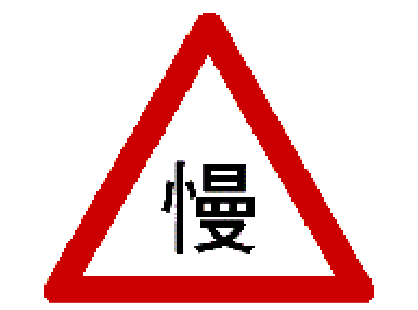
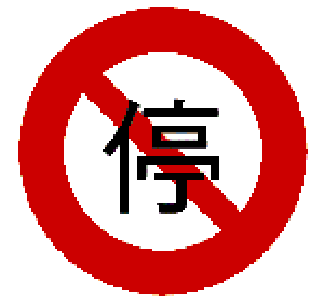
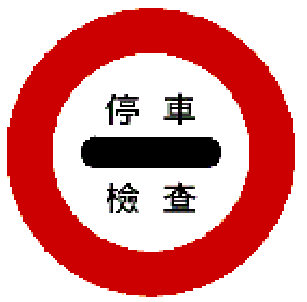








Reminders:
- Text marked in yellow specifies the correct answer in a multiple-choice question.
- The items listed above do not the complete learning material. Please study the PDF files or the official apps to learn the full material.
Further reading on road safety
Recommended articles and resources on that subject:
- Road Traffic Safety Portal Site
- Viewpoint: Silent communication on the road, a brief discussion on the use of direction lights and double yellow lights
- Why do some people always break traffic rules? Looking at the mentality of passers-by from the perspective of linguistics and game theory
- Taiwan is called “Pedestrian Hell”─Why are our road designs unsafe?
This marks the end of this article.
Any questions?
Feel free to let me know your feedback or questions. Comment under the article below or contact me. I am looking forward to your feedback!
Text of this article is licensed under CC BY.
This article is licensed under CC BY. ![]()


Leave a Reply